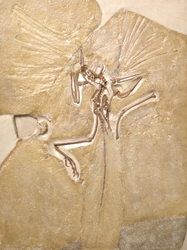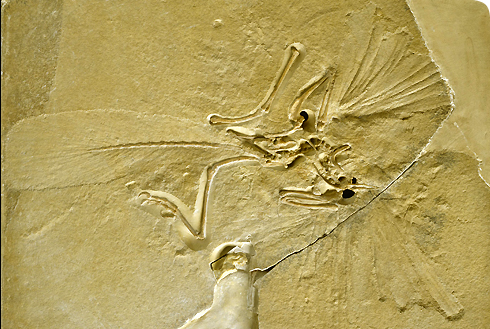Archaeopteryx lithographica

The skeleton and impressions of the wing and tail feathers are preserved on a slab of fine grained Solnhofn lithographic limestone
Archaeopteryx lithographica is widely considered to be the earliest known bird, although a paper in 2011 called its status as a bird into question. This fossil is a famous snapshot of evolution ‘in action’.
Archaeopteryx lithographica has a combination of dinosaur and bird characters that demonstrate conclusively modern birds are the descendants of small meat-eating dinosaurs. So not all dinosaurs became extinct!
Archaeopteryx lithographica had wings and feathers very like those of modern birds and a long bony feathered tail and was about the same size as a magpie.
Archaeopteryx's skeleton also has features in common with small meat-eating dinosaurs such as teeth with serrated edges and interdental plates and three fingers ending in claws.
Archaeopteryx lived in Late Jurassic times, 147 million years ago, where Germany is today.
Species detail
-

Dinosaur characteristics
Archaeopteryx has many skeletal features in common with small meat-eating dinosaurs such as Deinonychus and Velociraptor. Discover more about the features Archaeopteryx lithographica has in common with dinosaurs.
-

Bird characteristics
Archaeopteryx also has characters typical of modern-day birds. Wings with a flight feather arrangement just like modern birds and aerodynamic flight feathers with an asymmetric vane. Discover other features Archaeopteryx lithographica shared with modern birds.
-

Flight
Archaeopteryx was certainly capable of stable gliding flight with wings fully stretched. Discover more.
-

Distribution and habitat
Discover the habitat in which Archaeopteryx lived and the contemporary animals that shared its environment.
-

Colour
What colour was it? There are no actual feather tissues preserved. Artists have come up with a range of possible colour schemes. Find out more.
-

References
Get more references information about Archaeopteryx lithographica.
About the author
Dr Angela Milner
Angela was Associate Keeper of Palaeontology until 30 November 2009 and is now a Scientific Associate. She has published widely on dinosaurs and the origin of birds.

